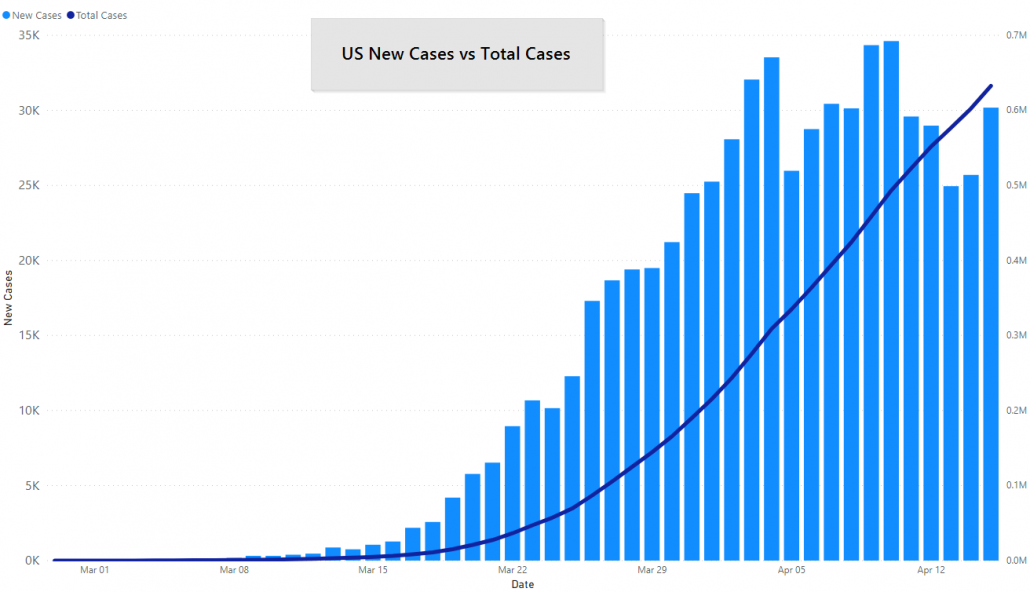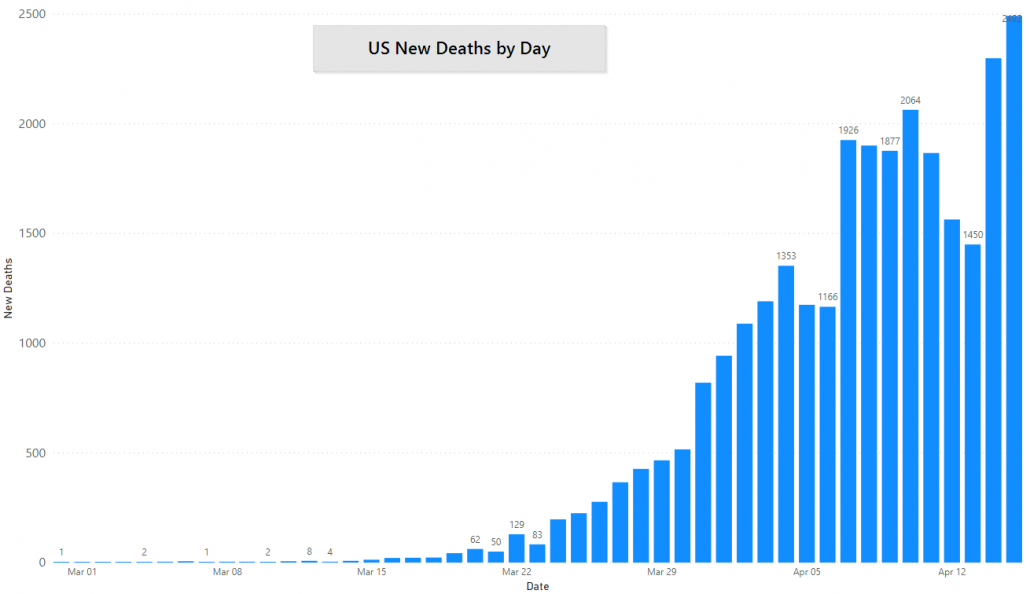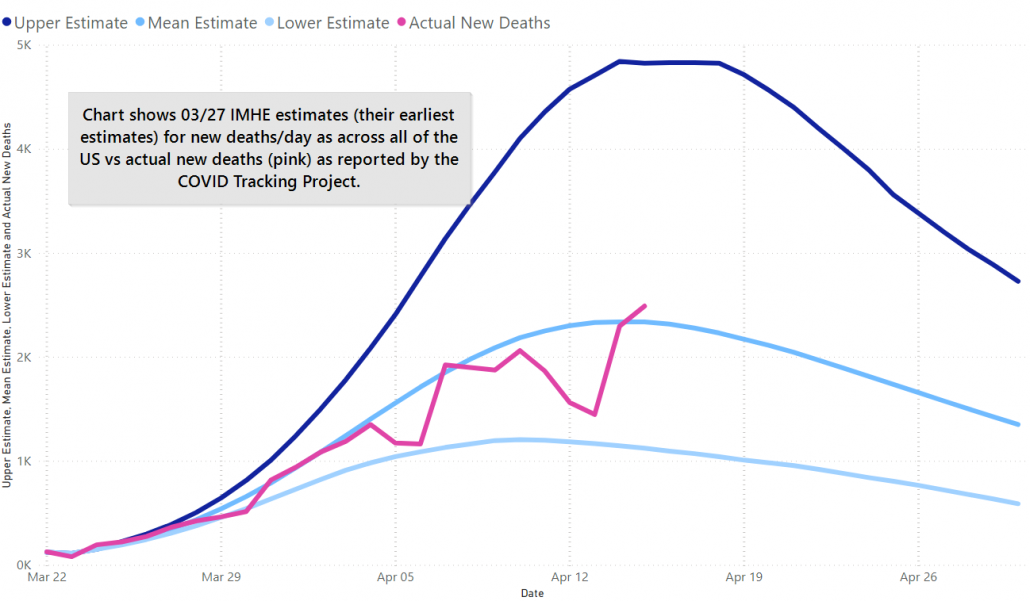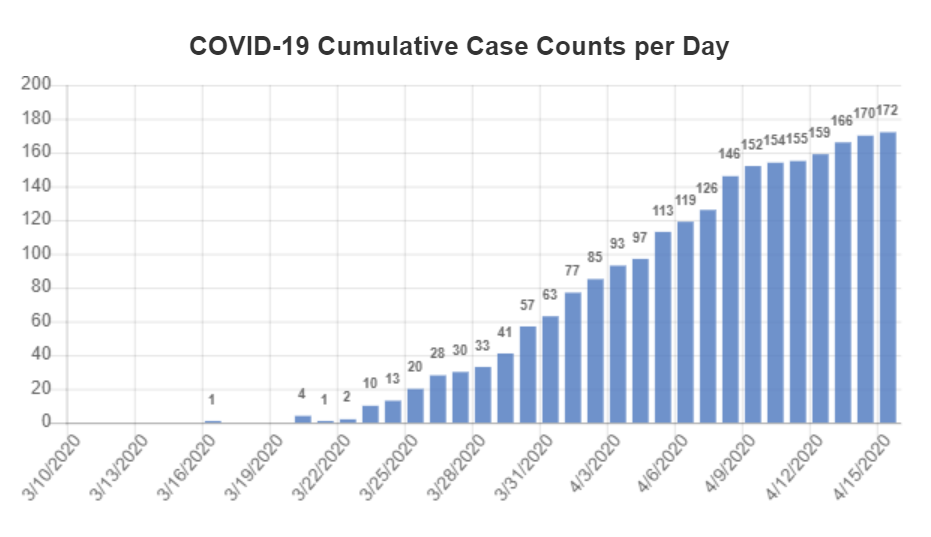Some of our data has changed notably from yesterday’s post. Specifically, yesterday had data lagging when we were making the charts and today we have current numbers (today’s) in, which typically lag 24-48 hours.
Also, it is common that some days show greater increases than others, based on when testing is available and reported back. It’s another reason we post primarily in graphic form, so you can visually identify the trend above any given day or week of data.
Numbers
Yesterday we said we were at four days of decline. Unfortunately, with updated data that is no longer the case. New York is showing a large increase today, of the 30,000 odd new cases today New York is 11,000 of them.
Deaths are also up. NY, NJ, CT, MI and MA make up 2/3rds of the new deaths so far today.
For context, we’re still tracking between the lower estimate and mean estimate from the March 27th IMHE model.
Looking at just Tennessee the data shows a downward trend over the whole month but the last week is about even. Tennessee is about to massively expand testing efforts (see below). If successful you can expect to see these new cases continue to rise. If that happens, it is likely the result of more testing, not a faster rise in new cases.
The Knoxville area continues to see a slow growth in cases:
Knox County is still the bulk of the area cases, and you can see that growth in new cases hasn’t changed notably since April 9th. Today, Dr. Buchanan was finally able to say, ” “We’re beginning to flatten the curve.”
News
Some of us got our personal stimulus funds today, it appears that those are widely rolling out for those with bank account numbers on file with the IRS.
The Paycheck Protection Program is widely expected to be out of funds today. Our take: it doesn’t matter, too much. No one we know has received funds yet and Congress will most likely approve an increase in funds. However, Congress is effectively in recess right now until May 4th. [1] So, it will be at least three weeks before more funds are appropriated.
Germany is beginning to lay out plans to lift lockdown. The EU announced advice on how to relax quarantines, which looks a lot like Tennesse’s (see below).
ABC News has a story about 100 cases and 44 deaths at a veteran’s long-term care facility in Massachusetts. The risk in these populations is extreme: people in LTC facilities typically are older and have underlying health conditions. Spain and Italy both had significant issues in keeping residents of such facilities safe from the COVID-19.
Science magazine has a paper from Harvard that says we may need to social distance into 2022. The authors include Marc Lipsitch, one of the world’s leading epidemiologists. We’ve written the same thing. This doesn’t mean we are at home for 2 years, it means that it is not business as usual for 2 years.
To avoid [exceeding critical care capacity], prolonged or intermittent social distancing may be necessary into 2022.
Projecting the transmission dynamics of SARS-CoV-2 through the postpandemic period
New York City has begun to report probable COVID-19 deaths. These are tracked separately but help to show, (1) the real scale of the outbreak in NYC, and (2) the difference between testing and reality.
Our take: the probable number looks better than expected. Some thought that testing could be off by a factor of 10.
Some rough math: NY state has about a 5% case fatality rate (1/20), if we take NYC’s confirmed+probable deaths (10,900) and multiply by 20 we end up with just over 200,000 cases, compared to the 111,000 confirmed cases.
Don’t do anything sciencey with that or assume you can extrapolate to other states. It is simply an exercise that gives us some rough estimates of where confirmed cases are (which we know we undercount) compared to actual cases (which is unknowable).
More importantly: use the confirmed+probable to understand the scope of the tragedy and situation.
Tennessee
Governor Lee officially recommended today that schools stay closed through the end of the year but declined to make it an order. Education Commissioner Schwinn said, ” “We will open schools next year and students will enter their new grades.”
Tennessee is going to expand its testing efforts, testing more people and testing more broadly. 15 drive-through sites will be run by the National Guard this weekend, you can find ta full list of weekend testing sites here. Find test sites for Knox County here.
Dr. Pearcy also promised that tests would be free, we think she meant department of health and drive-through tests, private providers can still charge.
If you think you need a test, we will test you.
Dr. Pearcy from TN Department of Health
Governor Lee was asked if the state would be open May 1st:
“We are waiting on the recommendations. That’s our goal, to open in May… that depends on the recommendations of the health care community, the business community… the most important thing is Tennesseans’ lives are protected and safe.”
“Tennesseans have been incredibly responsive to the [guidance] out there… It’s working, our curve has flattened. We need more confirmation of those numbers in the right direction, that haven’t been turned downward… we need some of those hospitalization numbers to not only stabilize but turn downwards.”
Governer Lee, April 15th, 2020 media briefing
This is the most specific we’ve heard him be so far.
The Tennessee Department of Health also promised to step up contact tracing, the process of tracking down anyone that has been in contact with someone who tested positive for COVID-19. Dr. Pearcy plans to hire another 150 people to work on this. For some context, Ars Technica says that there are only 2,200 people doing contact tracing in the US right now. Massachusetts is trying to hire 1,000 people for this right now.
Testing and tracing is essentially the plan we’ve seen followed by places such as Hong Kong, Singapore and South Korea, all of which have been more successful than most western countries in fighting COVID-19. Also, to be clear, social distancing doesn’t go away with this: it is something of a compromise between a lockdown and full-open. The testing and tracing plan is also the backbone of a number of other plans to re-open the US economy. There is skepticism from some corners that it is possible at the scale we need it at. We’re not epidemiologists, so we are just going to note that those disagreements exist.
Economics
To add some more color to what we wrote yesterday, Goldman Sachs is predicting that the economic downturn will be the worst in history, while the upturn will be the best. That sounds sensationalist in one regard, to us IT folks it sounds a lot like, “we turned it off and back on again.”
The Wall Street Journal has an article via MSN about how layoffs are affecting white-collar workers. We mention it here to reduce surprise: of course, there are going to be layoffs in virtually every sector of the economy. This is the natural result of asking pretty much everyone to stay at home and stop working. It doesn’t mean that those jobs will not come back.
We mentioned yesterday that the IMF is predicting the greatest recession since the Great Depression. Today, Axios reports that is the optimistic version:
The coronavirus pandemic will bring about the worst economic downturn since the Great Depression, the IMF predicted Tuesday in its latest World Economic Outlook — and that is its optimistic outlook.
Axios
For the first time since the Great Depression both advanced economies and emerging market and developing economies are in recession. For this year, growth in advanced economies is projected at -6.1 percent… Income per capita is projected to shrink for over 170 countries. Both advanced economies and emerging market and developing economies are expected to partially recover in 2021.
IMF
We share this so you can plan, see yesterday’s post.
A 3% contraction will be painful. a 6% contraction would feel absolutely awful. A lot of jobs are going to be gone.
And yet, even a 10% reduction in US GDP per capita leaves us above 2010 levels [2]. The balance is understanding that life will get worse and we think — right now — we’re not headed for the dustbowl. Even the much worse 1918 influenza left the economy in place. We’d have to destroy it ourselves a few years later.
US GDP per Capita, 1947 – 2019

Finally, we could be wrong on all of this. There really isn’t a precedent to compare to. However, we’ll continue to give you what we believe are the most balanced takes available.
Get In Touch
Need help thinking this through? Access to more data? Help getting your technology in order to handle what’s here and what’s coming? Contact us today.
Other
Thanks to those that have shared kind words or liked these posts. We’re doing out best to put out data-driven analysis, each one of these takes about 2 hours. It’s helpful to know that they are being read.
If you want copies of the Excel sheet and PowerBI Reports we use to put these together email us, info@jmaddington.com. Right now, our PowerBI combines data from JHU, NYT, COVID Tracking Project, IMHE and the TN Department of Health. Most sets are updated daily.
[1] The Senate is not fully recessed, holding pro forma sessions in which nothing gets done, or is supposed to, but prevents the President from making recess appointments. [2] Income equality, which has risen recently, in the US, however, means that people will feel this drop very differently. That is a different post.
Download our Report!
Get your copy of What Every Business Owner Must Know About Hiring an Honest, Competent, Responsive, and Fairly-Priced Computer Consultant.







